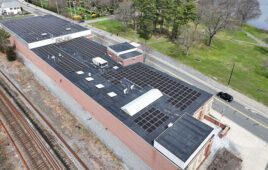The SUN DAY Campaign has reviewed the latest batch of data from FERC and determined that U.S. electrical generating capacity by renewable energy sources (biomass, geothermal, hydropower, solar, wind) has now — for the first time — surpassed that of coal.
FERC’s latest monthly “Energy Infrastructure Update” report (with data through April 30, 2019) notes that 18 units of new wind capacity (1,545 MW) and 102 units of new solar capacity (1,473 MW) were added during the first four months of this year. Coupled with four units of new hydropower (29 MW), that was enough to push renewable energy’s share of total available installed U.S. generating capacity up to 21.56%. By comparison, coal’s share dropped to 21.55% (down from 23.04% a year ago).
FERC’s data also reveal that the nation’s renewable energy capacity has been adding, on average, a percentage point each year (2018: 20.66%; 2016: 18.16%). The share of the nation’s generating capacity provided by utility-scale solar alone has more than doubled during the past three years from 1.42% to 3.23%. Meanwhile, wind’s share has increased from 6.43% to 8.25% and is now on track to surpass hydropower (8.41%) within the next few months.
Moreover, the same report indicates that by May 2022, proposed “high probability” generation additions and retirements could result in a net increase in renewable energy capacity of 40,993 MW. By comparison, net capacity by nuclear, coal, oil, and natural gas combined could actually decline by 24 MW from retirements.
While net growth by just natural gas is projected to be 18,530 MW, that is more than offset by net losses for coal (12,409 MW), nuclear (5,106 MW), and oil (1,039 MW). And even natural gas’ projected net growth will be dwarfed by that of wind (25,117 MW) and almost equaled by that of utility-scale solar (14,846 MW).
Further, if FERC’s projections prove accurate, in three years, renewable energy sources will provide nearly one-quarter (24.15%) of the nation’s total available installed generating capacity with wind alone accounting for over a tenth (10.01%) and solar at 4.32%. The balance will be provided by hydropower (8.16%), biomass (1.33%), and geothermal (0.33%).
News item from SUN DAY





At best the headline is wrong; at worst the headline is intentionally misleading. The figures in the article state capacity, not “electricity generated” or “renewable energy”. Coal actually generates several times more energy than renewables, although that gap is narrowing. In my area for example, capacity factors for coal are about 6 times greater than renewables, meaning that coal produces 6 times the energy for every unit of capacity. Hopefully non-subsidized energy storage and non-subsidized renewables will get cheap and reliable enough to significantly narrow this capacity factor gap, thereby providing a sensible reason to phase out of coal.
Capacity as a measure of contribution neglects the availability factor. Thus coal contributes much more energy to the national grid.
RPSs are like quotas (the worst possible trade tool) and they drive up prices paid, creating opaque subsidies to sellers of renewables and increased costs for buyers. I’m not surprised that RPSs have driven large scale adoption. Between the opaque subsidies and the value reductions of intermittent delivery, it’s really hard to know just what the cost to buyers in total has been however.
Fantastic news Kelly. Very nice article BTW…